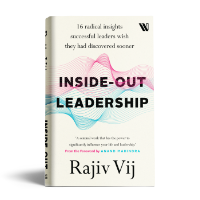Mark Twain might as well have been talking about climate change when he famously remarked, “Everybody talks about the weather, but nobody ever does anything about it.”
Climate change is for real and its alarming impact has been evident all around us. The proportion of hurricanes reaching categories 4 or 5 worldwide has risen from 20% in the 1970s to 35% in the 1990s; the increased frequency of extreme local weather like the 2003 heat wave across Europe that killed over 30,000 people; the receding glaciers (according to the UN, Himalayan glaciers could disappear by 2035 possibly impacting over two billion people); the increasing deterioration of ecosystem and the ensuing diseases with newer mutants of viruses; and the disappearing bee colonies, impacting agricultural produce in many developed countries, are all examples of this change. It is even leading to social strife in parts of the world – the reduction in rainfall in Darfur has turned millions of hectares of already marginal land into desert, leading to one of the largest social conflicts. As we look into the future, the dangers of increased hurricane activity in Central America and Southern US, the risks of places like Maldives, Bangladesh and Cairo being exposed to higher sea levels, the challenges of large scale social migration, and spread of new and unknown diseases worldwide are ominous.
While there’s a significant debate (although often more political than scientific) about whether humans are causing this climate change or if it is merely the result of a broader planetary cycle of change, the scientific community unequivocally suggests that humans are contributing to it. As we know, one of the biggest causes of climate change is the rising level of carbon emissions, brought about by burning of fossil fuels, like oil and coal, by cars, planes, homes, factories, and power plants. On average in the US, a passenger car emits over 5 tons of CO2 every year and a home emits 4 tons of CO2 per person each year. The Ecological Footprint Network has estimated that humanity’s burden on the planet now exceeds its carrying capacity – we use 1.3 planets to provide the resources we use. Moderate UN scenarios suggest that at the current trend of population growth and consumption, by the mid 2030s, we will need the equivalent of two Earths to support us. Research on global consumption levels done by Professor Jared Diamond of UCLA highlights that as developing countries, led by China and India, aspire to match the consumption levels and lifestyle of the developed nations, the world is likely to face a major resource crunch – for food, oil, metals, water and so forth. India and China together catching up would triple the global consumption rates. Further, the lifestyles of the wealthy and city folk account for majority of this global footprint – the wealthy 25% of the world’s population has a footprint equivalent to the Earth’s entire sustainable productive capacity.
It is also quite evident that this is not an issue we can hope to sort itself out with time. Despite the uncertainties of various projections, the risk of not doing something effective are way too high and can be devastating. Now, the solutions to this challenge include the roles of the Government, business as well as individuals. Governments around the world can contribute in multiple ways – by according high priority to sustainability in all their policies, raising awareness about climate change, introducing suitable tax breaks for businesses to embrace green technologies, actively promoting setting up of effective carbon pricing and trading exchanges as well as earmarking a meaningful budget towards research and development of non carbon emitting technologies. Businesses have a significant role to play in reducing and potentially reversing the damages of climate change. Organizations can begin by reviewing, reducing, and potentially capping, their direct and indirect carbon emission linked with their entire operation – the technologies they use, the location and type of raw materials they source, the extent of fossil fuel energy they consume through electricity and airplane transportation and so forth. Globally, buildings alone contribute to as much as a third of all greenhouse emissions – employing suitable temperature regulating technologies can not only reduce the level of emissions, but also save money for businesses. Similarly, restricting air travel to only the most critical meetings can greatly help reduce carbon emissions – not only does it take ten tons of ordinary fuel to produce one ton of Jet fuel, but it also happens to burn much higher in the Earth’s atmosphere, making it a deadly proposition. At a deeper level though, it’s the organizations’ resolve to incorporating social and environmental goals in every aspect of their business conduct that can have a real longer-lasting impact. Coined by John Elkington and ratified by the UN, the proposition to expand the role of organizations from merely delivering profits to being responsible for the triple bottom line (profits, people and planet) is a significant step in the right direction.
Finally, there’s an awful lot that each of the global citizens can do. From driving less and using alternate means of transportation to driving more fuel efficient cars; from buying energy saving light bulbs to choosing goods made from environment-friendly technologies; from eating more organic foods to turning vegetarian; from consuming less to buying goods produced in the neighboring communities; from cutting less trees to planting more and so forth. To my mind, while all the three segments- Government, businesses, and individuals- have meaningful contributions to make towards helping save this planet, in the longer-term, the greatest power and responsibility of change perhaps lies with the individuals. When individuals begin to make appropriate choices, the policy makers and the businesses will willingly follow that lead. Left alone, the Government may have to juggle multiple political compulsions – despite a broad global agreement to reduce carbon emissions by 60% in 1990, the emissions actually grew by 15% by 2001. Similarly businesses, driven by overly capitalistic objectives, maybe tempted to rewarding primarily the financial shareholders. Based on new choices that consumers begin to make, businesses may find going green not only environment friendly, but also better business.
Furthermore, at its very root, climate change is essentially a symptom of the deteriorating relationship individuals have with their environment, the planet, and the universe. It appears that since the industrial revolution, we have been paying disproportionate attention to scientific and technological advancement and much less to the development of our inner selves – resulting possibly in the current ecological imbalances. Recognizing this requires a fundamental mindset shift – entails paying attention to understanding our true identity and our interconnectedness with all beings and with nature. As the authors of Natural Capitalism highlight, “While it is unwise to believe in any one environmental projection of the future, it is important to bear in mind that nature bats last and owns the stadium.” Only when we commit to growing our self-awareness and building clarity of our personal purpose (one that encapsulates our social and environmental linkages), can we learn to live in harmony with nature and make real and sustainable progress to tackle climate change.
This journey has to begin with each of us – hopefully then spreading to our families, communities and the broader society. Top-down decisions, devoid of this sense of purpose and inner conviction, can have limitations of not being holistic. For example, encouragement of bio-fuels as replacement for fossil fuels has already led to greater global deforestation to plant corn, sugarcane and palm oil – resulting in both fresh emissions as well as higher food costs. When we make a commitment to the journey of personal change, it begins to reflect in each of our thoughts, beliefs and actions. As we relate to plants and earth as living beings, we acknowledge that single-minded pursuit of profit and growth, like cancer, is dangerous for the survival of the whole and are naturally drawn to sustaining a healthy co-existence. Also, learning to live with greater mindfulness, we then take decisions out of conscious choice rather than out of a sense of sacrifice and compulsion. Finally, public sector and private enterprise leadership is nothing but a collection of individuals – when they personally commit to this journey, the Government and business decisions too automatically sing in greater ‘natural’ harmony.
Related Search Terms:
climate change in India /what is climate change /causes of climate change /global climate change /global warming and climate change











 What Are You More Afraid Of: Failure Or Rejection?
What Are You More Afraid Of: Failure Or Rejection? Domination of Our Senses and Personal Mastery
Domination of Our Senses and Personal Mastery ALIGNED: 7 Happiness Mantras I Wish I Could Follow
ALIGNED: 7 Happiness Mantras I Wish I Could Follow Beware Of The Trap Of Successism
Beware Of The Trap Of Successism 7 Lessons in 7 Years!
7 Lessons in 7 Years!